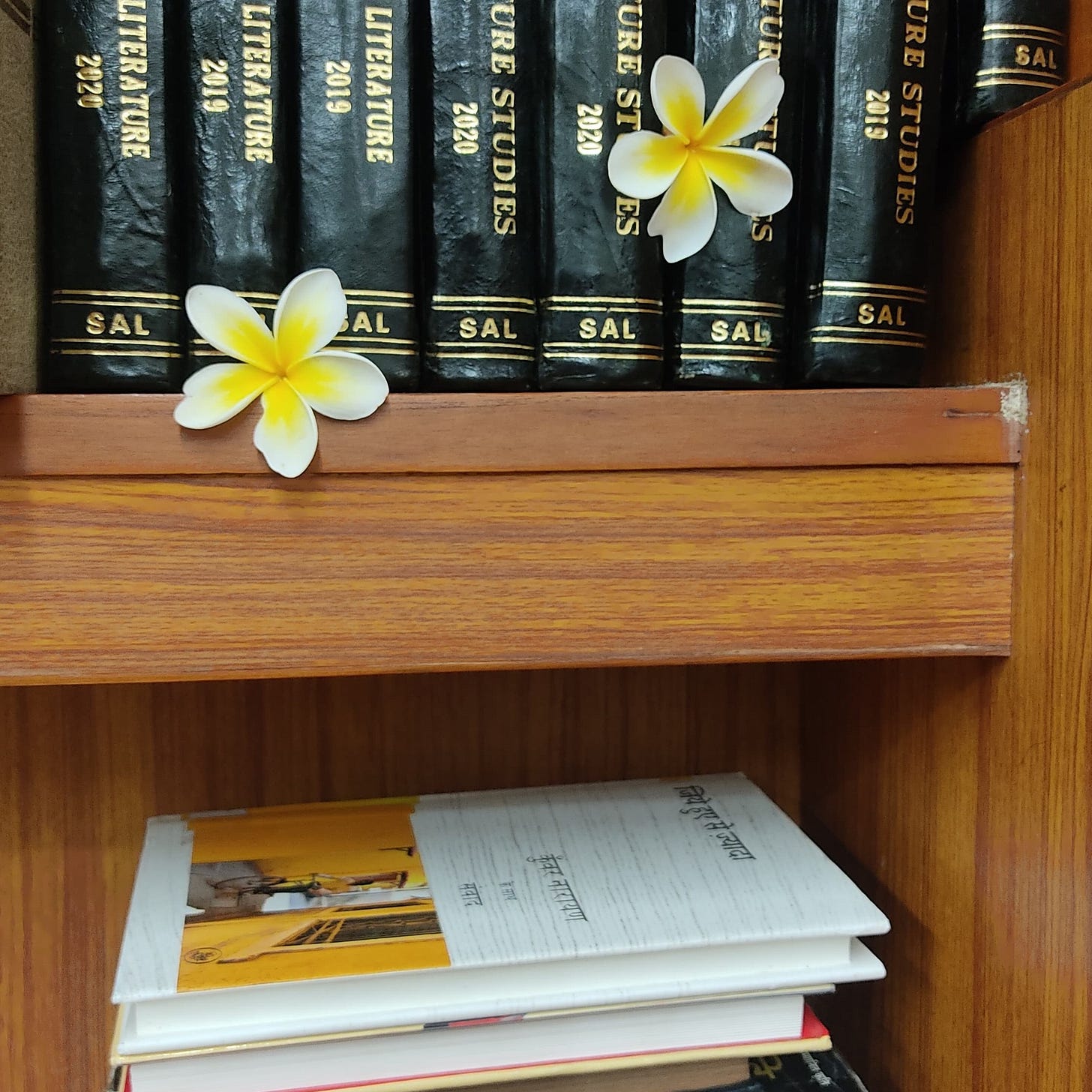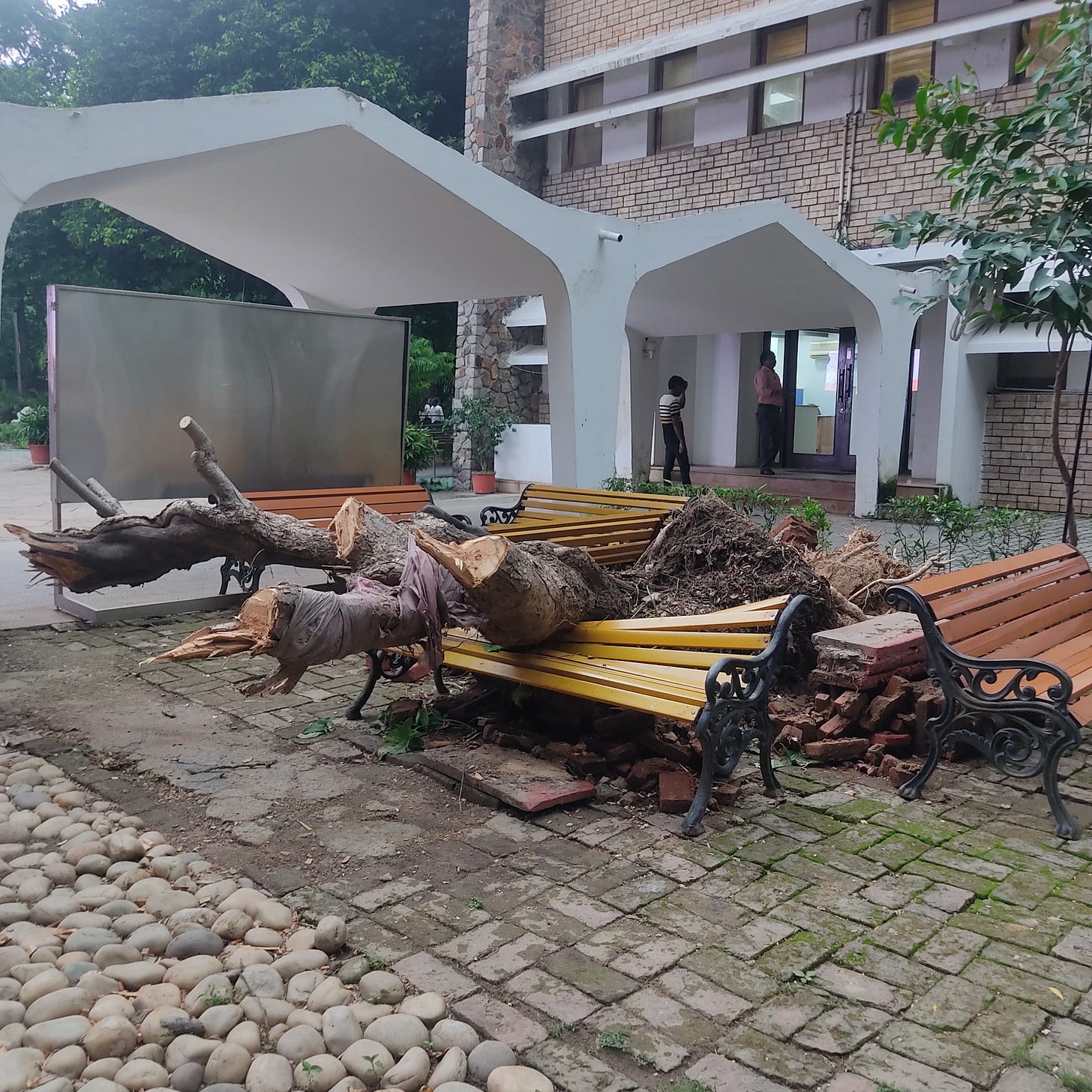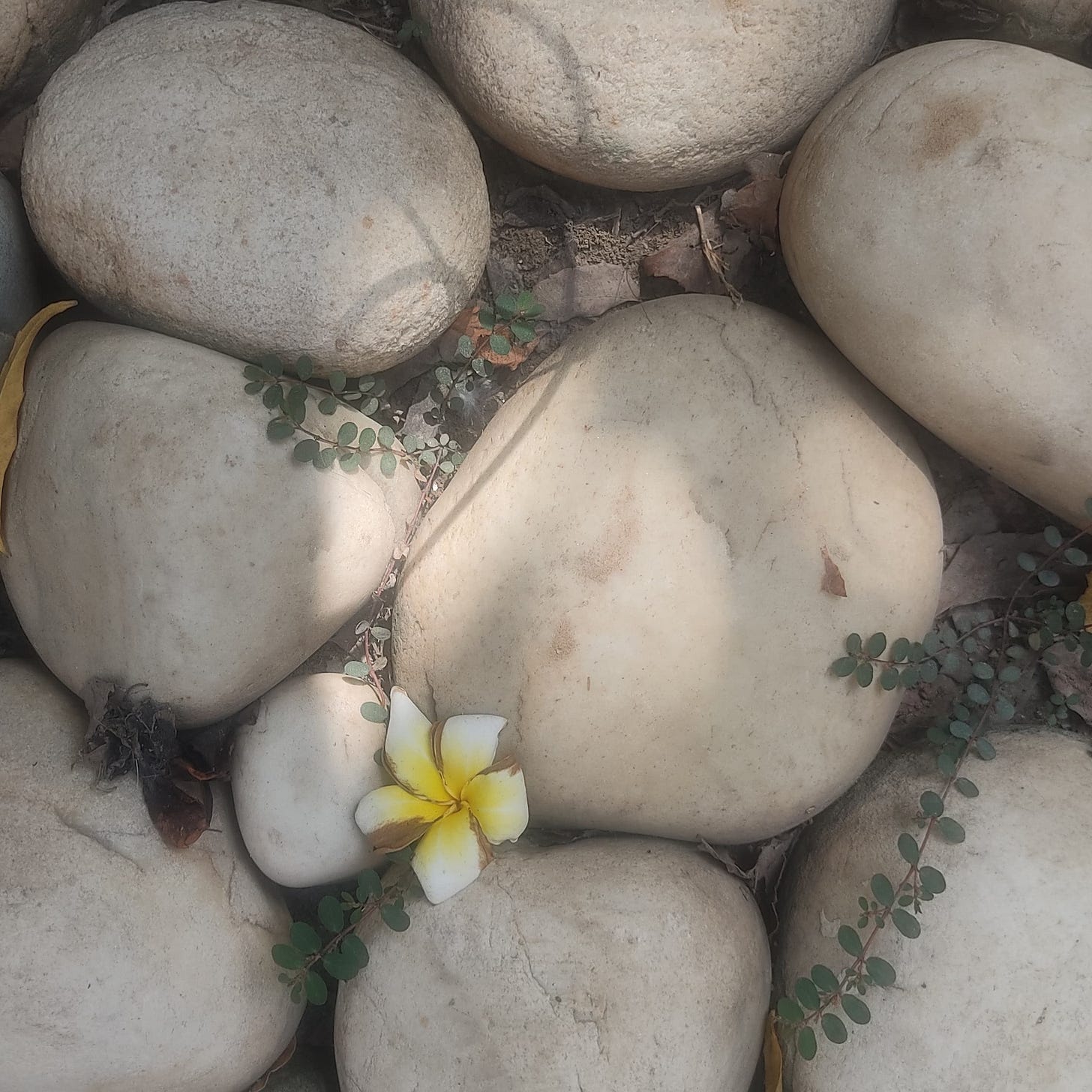Eulogy for the fallen Champa Tree at Rabindra Bhavan
The Tree is gone, and I want to tell everyone about it.
Something looked different as I walked through the Rabindra Bhavan complex in Mandi House on Tuesday, the 10th of September. It looked emptier, even permanently changed in a way I was yet to understand. As I walked further in, I realise what had happened. The expansive Champa Tree, under which I had spent many summer afternoons eating packed lunches- sometimes alone, sometimes in company- was missing. It had simply disappeared, leaving behind an imposing sky.
My first reaction was rage. How dare they cut the Tree! Do they not know it’s illegal to cut full-grown trees! However, as I reached closer, I saw the bare stump of the Tree, with its roots intact, resting on the yellow iron bench that once sat under its shade. The impact of its fall had crushed the backrest of the bench, causing a depression to form in its centre. The branches, with their elongated leaves and milky white flowers had been cleared away. I recalled that the Tree had begun to break free from one edge of its cubical brick cage the last time I saw it. It had warned us of its imminent fall a few weeks before it succumbed.
The guard at the Lalit Kala Akademi Art Gallery, in whose lawn the Tree once stood, eyed me curiously as I walked around, taking photos of the fallen Frangipani from different angles. The Tree, and now its fallen remains, were in direct sight from where he was positioned. He walked up to me to inquire. Soon, we found ourselves engaged in a conversation about the life and the fall of the Champa Tree. I reminisced about the numerous days I had taken shelter under its comforting shade, only to be enamoured by squirrels bouncing on and off its thick branches, or to witness the white flowers with deep yellow centres fall from it like they were gifts from god herself. And, he, in turn, spoke to me of its peaceful fall. “It had begun to come down on Friday, the 6th of September”, he informed. And by Sunday, when the offices were closed and most of the white-collar staff was on leave, the Tree had completely detached itself from the brick cage and onto the yellow bench. Frangipanis, generally don’t grow into massive trees in Delhi. However, the one at the Rabindra Bhavan was huge- one of the largest I have seen in the city, sheltering as many as seven full-sized benches strategically placed under it. One would expect it to fall with a thud. Instead, “it was very gentle, very quiet in its fall,” the guard recalled. “Ekdum shaanti se gira, kisi ko kuch nuksaan nahi”, he tilted his head and closed his eyes for a few seconds as he recalled the details, as if the Tree had only fallen into a deep sleep. They had planted the branch cuttings in the lawn next to the boundary wall. “There was one Tree, now there would be many”, he added reassuringly. But it won’t be the same Tree at the same spot. Neither will the branches be distributed in the exact same pattern. Nor will the flowers fall directly between the bars of the benches or into the spaces between small rocks on the ground. I wanted to say all of this to him, but I simply nodded.

The first time I became conscious of the Tree was through one of its fallen flower, that sat nestled between two bars of a bench. The flower, with its five milky white petals bursting out from the kesari centre, bore no sign of browning or a tear. Wise ones might argue against perfection, but the flower was perfect in every sense of the word- in its symmetry, its colours, its softness, its freshness, and even in its fall. Finding it hard to defy the primal need to possess that which is beautiful, I picked the perfect flower. Immediately, my eyes began to search for more freshly fallen flowers that were yet untrampled upon, that were yet undamaged by the inevitable forces of nature.
I was unfamiliar with the species of the Tree at the time or, how common it was across the city, or that it had also been growing in my grandmother’s backyard all this while, or that it held great literary and religious significance. Some days, I would pick fallen flowers in the lunch hour, carry them inside the library and scatter them on my desk. Or, fit their hollow stems in between the spines of hardbound collections of journals stacked on the top. Days later when I would return, the dried brown carcasses of some of the flowers would still be hanging from between the spines, threatening to fall off at any moment.

Now, the entire Tree had fallen. The brick cubicle had proven too small to hold its growing roots. The Tree had fallen, and no one at the Akademi could tell me how old it had been. Instead, in their typical bureaucratic ways, they directed me from one person to another, from one room to another in my quest to find the age of the fallen Tree in human years.
A staff member suggested that I might find my answers in Room #103 on the first floor. As I entered the room, I noticed that it has a wide glass window overlooking the Tree (or the empty space where the Tree once stood). An officer sat behind a large wooden desk, his back facing the window. I asked him about the age of the Tree. “It is not a tree”, he quickly answered. “Are you from some department?” he inquired. No, I am a member at the library and I just wanted to write about it. “It’s a flowering plant. It’s planted all around the sides of the roads in Mandi House. You can go see for yourself”, he defensively added. “It is not supposed to grow beyond a certain height. We don’t know how this one grew so tall and big.”
A plant cannot possibly provide shade to seven full sized benches, I wanted to argue (later, I was relieved to find it in Pradip Krishen’s field guide to the Trees of Delhi where he categorises it as a small tree, but a tree nonetheless). Instead, I assured him by repeating myself- I just want to know when it was planted, maintaining a friendly smile throughout. “It must be 6-7 years old”, he answered vaguely. It is definitely older than that, I politely pushed back. The guard, who had been posted there for more than 17 years, had told me that the Tree predated his time at the Akademi.

Only last month I sat on the benches looking up at the bright blue monsoon sky. The branches of the Champa, with its long leaves, had come to almost touch the white concrete shed leading to the gallery. They looked like two lovers yearning to embrace each other, separated by a fragment of the sky. I sat there and watched the sky for a few seconds longer. Ek tukda aasman. A fragment of the sky, I had whispered silently, committing the image simultaneously to my memory, and to my phone’s.
Now the Tree is gone, and the sky is, once again, too vast to be contained in my finite memory. The Tree is gone, and I want to tell everyone about it.
Here is a poem by Rabindra Nath Tagore to complement this piece- The Champa Flower. If you want to read more about the species, visit this piece by JSTOR.







Such a beautiful, moving essay! The perfect writerly way to preserve the memory of a fallen tree. Thank you for this, Ritika.
Such a beautiful eulogy! Love how gently yet firmly you remember things and write about them <3